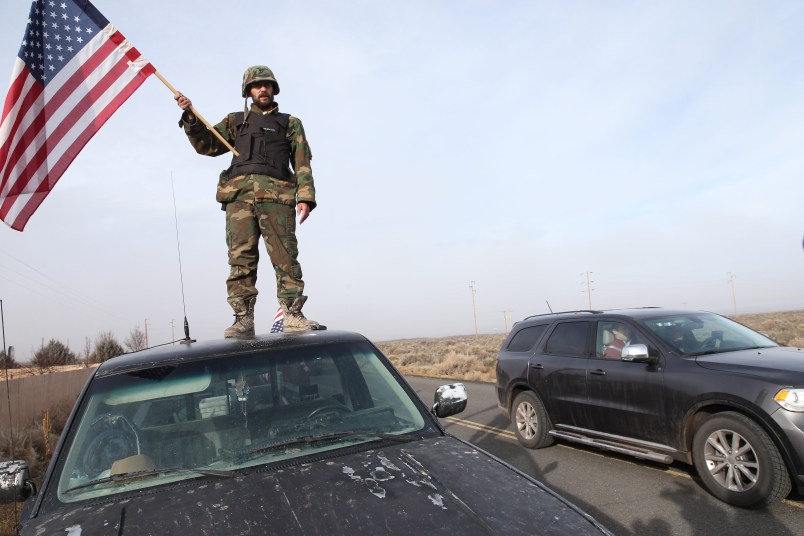The weeks-long occupation of a federal wildlife refuge in rural Oregon by anti-government extremists could have ended in a variety of ways — the most worrisome of which is the way of Waco or Ruby Ridge: violently. But Thursday the FBI was able to convince the remaining four occupiers to leave the Malheur National Wildlife Refuge voluntarily, a conclusion that one expert on anti-government extremism praised as a “nonviolent coda” that reduces the likelihood that sympathizers will seek retribution.
“The final resolution of the standoff, obviously it was tense and it had hiccups,” Mark Pitcavage, a senior researcher at the Anti-Defamation League, told TPM. “But the fact that the four all finally ended up giving themselves up and no one was hurt, and because this was presumably the end of the whole ordeal, it added this nonviolent coda which will characterize that standoff as a whole.”
Such a characterization is important, because any time extremists perceive — rightfully or wrongfully — that the government is to blame when an encounter like this turns violent, it risks breeding more anti-government acts in response. Timothy McVeigh, the Oklahoma City bomber, was said to be inspired by the violent confrontation that ended the Waco siege, which he believed amounted to the government waging war on Americans.
Already, LaVoy Finicum — one of the leaders of the occupation — has been revered as a martyr in anti-government circles after he was shot and killed in an encounter with law enforcement last month at a traffic stop miles away from the refuge. Thursday, after three of the final occupiers departed the facility, the fourth, David Fry, seemed to back out of the plans to turn himself over to the authorities. After an hour of him panicking, authorities and some of his colleagues were able to persuade him to finally leave.
“If events had been switched and if LaVoy Finicum’s death had come last, that would have left a very different impression on a lot of people’s minds,” Pitcavage said. “I think it’s a very good thing that the final four people were able to be coaxed into surrender without there being any need to use force and without there being any casualties for anyone involved.”







Negatory, good buddy. The non-violent approach at the Bundy ranch encouraged the Oregon invasion.
If the FBI and BLM had gotten off their lazy butts and done something at the Bundy ranch, like arrest him and seize his cattle to help payoff the back grazing rent, it would have stopped there
Instead, they showed the government as cowardly and squishy, and the Patriot movement white trash laughed at them.
So you are saying violence was the way to go at the Bundy Ranch? And you think that would have been a good idea, and would have stopped future confrontations? Wow.
Who’s laughing now?
No, that would have made it worse. And by the way, the people here were protesting the ARREST and IMPRISONMENT of the Hammonds, totally unrelated to the Bundy Ranch. So that Law Enforcement action did not stop nuts from protesting.
I’m thankful people like you are not calling the shots (pun intended). Your cowboy approach reminds of of Bush, invade first, then think about what goes next.
If the feds had not backed down at Bundy Ranch, people would have been killed…they were completely ready to shoot the feds, from distance and with cover. I have wondered why they didn’t go back at them, but anything they tried would have had the same response. Now, I think the feds were waiting, and had embedded agents into the “patriot movement”, so they knew something like this was building up. And, after Oregon, the movement pretty much discredited itself in the eyes of Americans, just like McVeigh did to the militia movement (and without the horror and deaths). Sure, there will still be lots of yammering, but they pretty much lost their support beyond the fringe, and Bundy is now in jail as well (and you can bet the feds will put his fines as part of their case).
All in all, lots better than taking the fight to a bunch of people who wanted to fight and be martyrs for their cause.
I think he’s right about it leaving a better impression than it ending with violence, but I think you’re fooling yourself if you think these sovereign citizen oathkeeper bircher types have been convinced that they shouldn’t be trying to resort to their “second 'menment remedies” every chance they get in hopes of starting the new revolution/race war.
Just watch how fucking batshit they go if we win in November. They’re going to continue to escalate so long as there isn’t a fellow racist white conservative male in the WH trying to disassemble the federal gov’t because it’s now become an inconvenience to them, etc.
This assumes a certain amount of thought/reasonableness on the part of the armed yahoos. I think they are incapable of rational thought. Hell, they’ve already proven that.